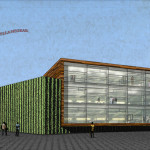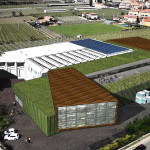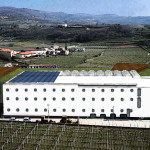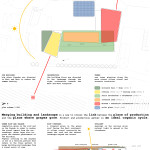WINE CULTURAL CENTRE
La fusione tra l’edificio e il paesaggio è un modo per sottolineare lo stretto legame esistente tra il luogo di produzione e il luogo dove cresce l’uva. Il prodotto e la produzione si riuniscono in un ciclo organico ideale.
La vegetazione cresce sulla facciata e sul tetto al fine di ridurre l’impatto visivo della struttura nell’ambiente circostante, migliorando allo stesso tempo anche le prestazioni termiche dell’edificio. Il rivestimento vegetale sulle facciate forma un disegno verticale che si riprende il modello dei vigneti al fine di fondere edificio e paesaggio da un punto di vista visivo.
Un vigneto cresce sulla porzione di tetto che si affaccia sul cortile Est, permettendo la continuità visiva con il paesaggio naturale al di là della strada. Un nuovo filare di alberi lungo la strada principale permette inoltre l’isolamento acustico e visivo proveniente dall’esterno.
I due grandi blocchi in legno dell’edificio, nei quali sono ospitate funzioni pregiate quali la sala degustazioni ed il museo, sono orientati verso i vigneti a est e ovest in modo da permetterne suggestive visuali; allo stesso tempo questo orientamento permette di ridurre il riscaldamento estivo, esponendo le ampie vetrate a ponente e levante.
Le aperture sul soffitto permettono alla luce naturale di diffondersi nel magazzino. I pannelli fotovoltaici sono installati sulla parte superiore del tetto per produrre energia elettrica, mentre i pannelli solari ad acqua sono installati in modo da ridurre il fabbisogno energetico per la produzione del vino (regolazione della temperatura di fermentazione).
Il percorso mussale interagisce con tutte le fasi di produzione, a partire dal vigneto sulla parte superiore del tetto, passando per i laboratori, i magazzini e le cantine. Si tratta di un itinerario educativo che comprende una biblioteca multimediale sensoriale.
Merging building and landscape is a way to stress the link between the place of production (the winery) and the place where grapes grow. Product and production gather in an ideal organic cycle.
Vegetation grows on the roof and the facade in order to reduce the visual impact from the surroundings. Green layers also improve the thermal performance of the building. Vegetal covering on the façades is set in a vertical pattern that refers to the vines pattern to merge building and landscape from a visual point of view.
A vineyard grows on the green roof facing the East courtyard: it allows visual continuity between the roof and the natural landscape beyond the street. New tree planting along the main street allows visual and acoustic insulation.
The building blocs are directed to the landscape through the right orientation towards the East and West vineyards; at the same time this direction allows to reduce the summer heating.
Openings on the ceiling allow natural light to spread in the storehouse. Photovoltaic panels are installed on top of the roof to produce electric energy. Water heating panels are installed in order to reduce the wine production energy requirements (fermentation temperature regulation).
The museum paths interacts with all the production phases starting from the vineyard on the top of the roof, going through the labs, the storehouses and the cellars. It’s an educative itinerary which includes a sensory multimedia library.





